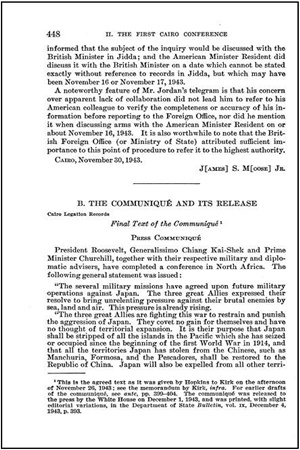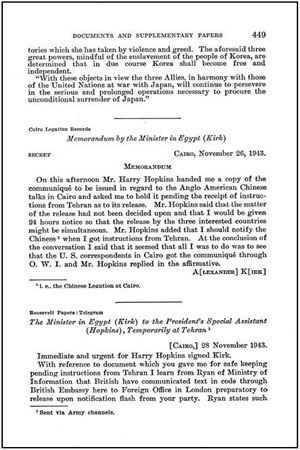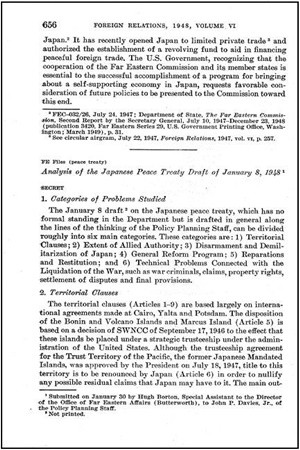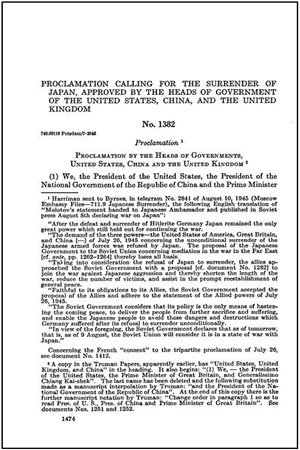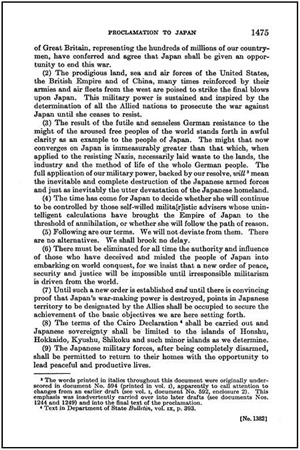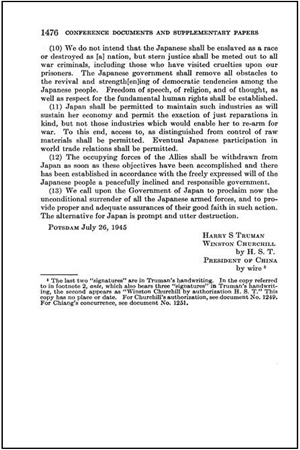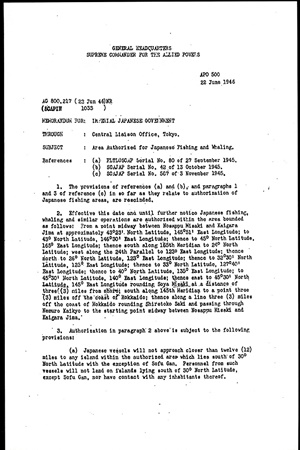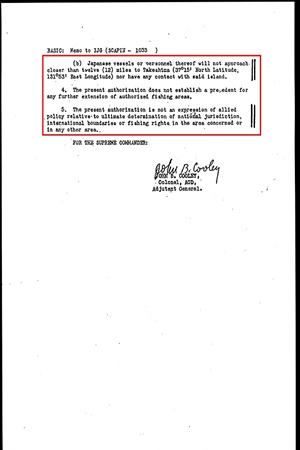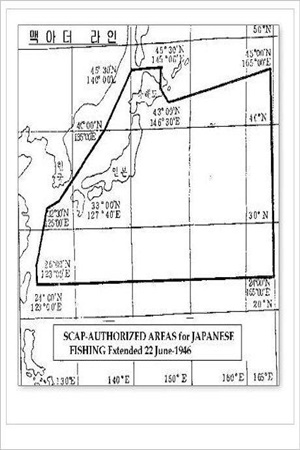The Cairo Declaration was a joint communique issued by the U.S., the U.K. and China and was not binding upon Japan. But as Japan accepted the Potsdam Declaration on July 26, 1945 (Soviet Russia acceded to it on August 8th) which incorporated the above stipulations of the Cairo Declaration in Article 8, it became an international instrument binding on Japan
North Africa
November 27, 1943
Department of State [USA], The Department of State Bulletin, No.232,p.393. Japan’s Foreign Relations-Basic Documents Vol.1, pp.55-56.
President Roosevelt, Generalissimo Chiang Kai-shek and Prime Minister Churchill, together with their respective military and diplomatic advisers, have completed a conference in North Africa.
The following general statement was issued:
(paragraph 1)”The several military missions have agreed upon future military operations against Japan. The Three Great Allies expressed their resolve to bring unrelenting pressure against their brutal enemies by sea, land, and air. This pressure is already rising.
(paragraph 2)”The Three Great Allies are fighting this war to restrain and punish the aggression of Japan. They covet no gain for themselves and have no thought of territorial expansion. It is their purpose that Japan shall be stripped of all the islands in the Pacific which she has seized or occupied since the beginning of the first World War in 1914, and that all the territories Japan has stolen from the Chinese, such as Manchuria, Formosa, and the Pescadores, shall be restored to the Republic of China(1). Japan will also be expelled from all other territories which she has taken by violence and greed(2). The aforesaid three great powers, mindful of the enslavement of the people of Korea, are determined that in due course Korea shall become free and independent.
(paragraph 3)”With these objects in view the three Allies, in harmony with those of the United Nations at war with Japan, will continue to persevere in the serious and prolonged operations necessary to procure the unconditional surrender of Japan.”
Article 8 of the declaration stipulates: “..The terms of the Cairo Declaration shall be carried out and Japanese sovereignty shall be limited to the Islands of Honshu, Hokkaido, Kyushu, Shikoku and such minor islands as we shall determine…” The declaration itself was also a joint communique of the four Great Powers and was not binding upon Japan before it accepted unconditional surrender on August 14, 1945, and signed the instruments of surrender on September 2 that year. Thus, Japan shouldered the responsibility of abiding by the Cairo and Postam Declarations.
Potsdam Declaration
July 26, 1945
(1)”..We-the President of the United States, the President of the National Government of the Republic of China, and the Prime Minister of Great Britain, representing the hundreds of millions of our countrymen, have conferred and agree that Japan shall be given an opportunity to end this war.
(2) The prodigious land, sea and air forces of the United States, the British Empire and of China, many times reinforced by their armies and air fleets from the west, are poised to strike the final blows upon Japan. This military power is sustained and inspired by the determination of all the Allied Nations to prosecute the war against Japan until she ceases to resist.
(3) The result of the futile and senseless German resistance to the might of the aroused free peoples of the world stands forth in awful clarity as an example to the people of Japan. The might that now converges on Japan is immeasurably greater than that which, when applied to the resisting Nazis, necessarily laid waste to the lands, the industry and the method of life of the whole German people. The full application of our military power, backed by our resolve, will mean the inevitable and complete destruction of the Japanese armed forces and just as inevitably the utter devastation of the Japanese homeland.
(4) The time has come for Japan to decide whether she will continue to be controlled by those self-willed militaristic advisers whose unintelligent calculations have brought the Empire of Japan to the threshold of annihilation, or whether she will follow the path of reason.
(5) Following are our terms. We will not deviate from them. There are no alternatives. We shall brook no delay.
(6) There must be eliminated for all time the authority and influence of those who have deceived and misled the people of Japan into embarking on world conquest, for we insist that a new order of peace, security and justice will be impossible until irresponsible militarism is driven from the world.
(7) Until such a new order is established and until there is convincing proof that Japan’s war-making power is destroyed, points in Japanese territory to be designated by the Allies shall be occupied to secure the achievement of the basic objectives we are here setting forth.
(8) The terms of the Cairo Declaration shall be carried out and Japanese sovereignty shall be limited to the islands of Honshu, Hokkaido, Kyushu, Shikoku and such minor islands as we determine.
(9) The Japanese military forces, after being completely disarmed, shall be permitted to return to their homes with the opportunity to lead peaceful and productive lives.
(10) We do not intend that the Japanese shall be enslaved as a race or destroyed as a nation, but stern justice shall be meted out to all war criminals, including those who have visited cruelties upon our prisoners. The Japanese Government shall remove all obstacles to the revival and strengthening of democratic tendencies among the Japanese people. Freedom of speech, of religion, and of thought, as well as respect for the fundamental human rights shall be established.
(11) Japan shall be permitted to maintain such industries as will sustain her economy and permit the exaction of just reparations in kind, but not those which would enable her to re-arm for war. To this end, access to, as distinguished from control of, raw materials shall be permitted. Eventual Japanese, participation in world trade relations shall be permitted.
(12) The occupying forces of the Allies shall be withdrawn from Japan as soon as these objectives have been accomplished and there has been established in accordance with the freely expressed will of the Japanese people a peacefully inclined and responsible government.
(13) We call upon the government of Japan to proclaim now the unconditional surrender of all Japanese armed forces, and to provide proper and adequate assurances of their good faith in such action. The alternative for Japan is prompt and utter destruction…”
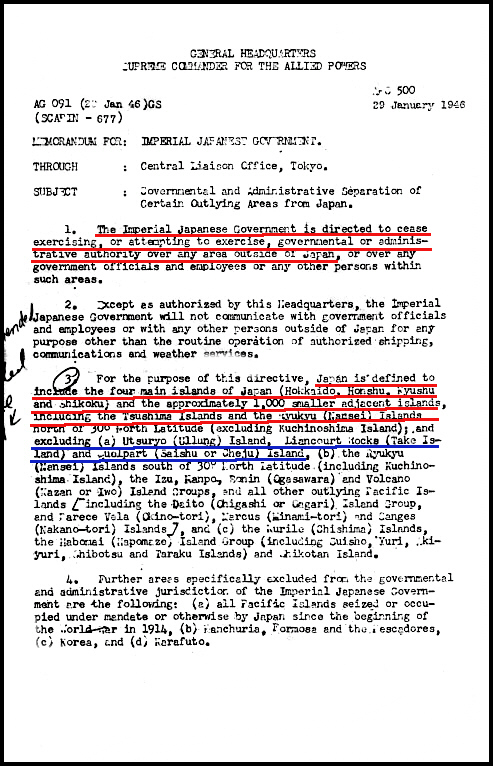 Originally Posted by Supreme Commander for the Allied Powers
Originally Posted by Supreme Commander for the Allied PowersGENERAL HEADQUARTERS
SUPREME COMMANDER FOR THE ALLIED POWERS
(500) AG 091(29 JanUARY 46) GS (29 January 1946)
(SCAPIN – 677)
MEMORANDUM FOR: IMPERIAL JAPANESE GOVERNMENT
THROUGH : Central Liaison office, Tokyo
SUBJECT : Governmental and Administrative Separation of Certain Outlying Areas from Japan.
1. The Imperial Japanese Government is directed to cease exercising or attempting to exercise, governmental or administrative authority over any area outside of Japan, or over any government officials and employees or any other persons within such areas.
2. Except as authorized by this Headquarters, the Imperial Japanese Government will not communicate with government officials and employees or with any other persons outside of Japan for any purposes other than the routine operation of authorized shipping, communications and weather services.
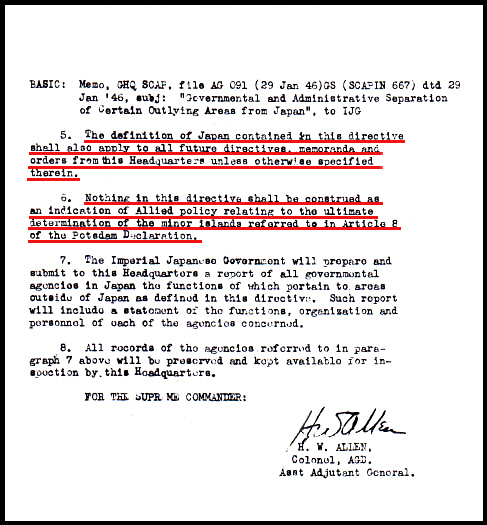 3. For the purpose of this directive, Japan is defined to include the four main islands of Japan(Hokkaido, Honshu, Kyushu and Shikoku) and the approximately 1,000 smaller adjacent islands, including the Tsushima Islands and the Ryukyu (Nansei) Islands north of 30° North Latitude (excluding Kuchinoshima Island); and excluding (a) Utsuryo(Ullung) Island, Liancourt Rocks( Take Island) and Quelpart (Saishu or Cheju) Island, (b) the Ryukyu (Nansei) Islands south of 30° North Latitude(including Kuchinoshima Island), the Izu, Nanpo, Bonin (Ogasawara) and Volcano (Kazan or Iwo) Island Groups, and all other outlying Pacific Islands including the Daito(Ohigashi or Oagari) Island Group, and Parece Vela (Okinotori), Marcus (Minami-tori) and Ganges (Nakano-tori) Islands, and (c) the Kurile (Chishima) Islands, the Habomai (Hapomaze) Island Group (including Suisho, Yuri, Akiyuri, Shibotsu and Taraku Islands) and Shikotan Island.
3. For the purpose of this directive, Japan is defined to include the four main islands of Japan(Hokkaido, Honshu, Kyushu and Shikoku) and the approximately 1,000 smaller adjacent islands, including the Tsushima Islands and the Ryukyu (Nansei) Islands north of 30° North Latitude (excluding Kuchinoshima Island); and excluding (a) Utsuryo(Ullung) Island, Liancourt Rocks( Take Island) and Quelpart (Saishu or Cheju) Island, (b) the Ryukyu (Nansei) Islands south of 30° North Latitude(including Kuchinoshima Island), the Izu, Nanpo, Bonin (Ogasawara) and Volcano (Kazan or Iwo) Island Groups, and all other outlying Pacific Islands including the Daito(Ohigashi or Oagari) Island Group, and Parece Vela (Okinotori), Marcus (Minami-tori) and Ganges (Nakano-tori) Islands, and (c) the Kurile (Chishima) Islands, the Habomai (Hapomaze) Island Group (including Suisho, Yuri, Akiyuri, Shibotsu and Taraku Islands) and Shikotan Island.
4. Further areas specifically excluded from the governmental and administrative jurisdiction of the Imperial Japanese Government are the following: (a) all Pacific Islands seized or occupied under mandate or otherwise by Japan since the beginning of the World War in 1914, (b)Manchuria, Formosa and the Pescadores, (c) Korea, and (d) Karafuto.
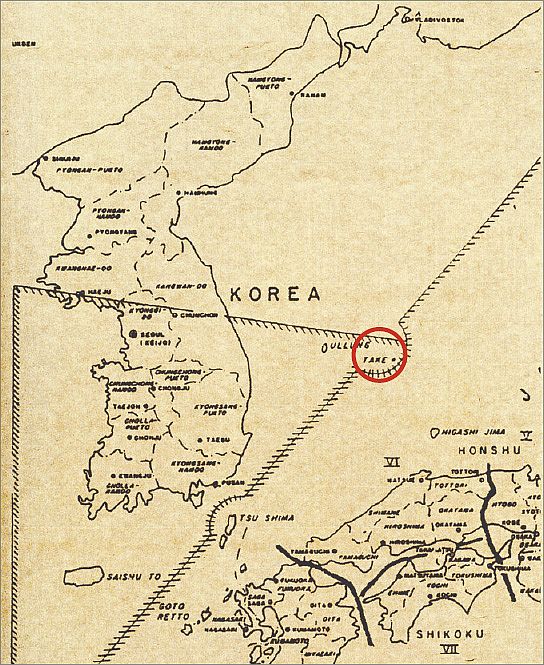 5. The definition of Japan contained in this directive shall also apply to all future directives, memoranda and orders from this Headquarters unless otherwise specified therein.
5. The definition of Japan contained in this directive shall also apply to all future directives, memoranda and orders from this Headquarters unless otherwise specified therein.
6. Nothing in this directive shall be construed as an indication of Allied policy relating to the ultimate determination of the minor islands referred to in Article 8 of the Potsdam Declaration.
7. The Imperial Japanese Government will prepare and submit to this Headquarters a report of all governmental agencies in Japan the functions of which pertain to areas outside of Japan as defined in this directive. Such report will include a statement of the functions, organization and
personnel of each of the agencies concerned.
8. All records of the agencies referred to in paragraph 7 above will be preserved and kept available for inspection by this Headquarters.
FOR THE SUPREME COMMANDER :
(sgd.)
H.W. ALLEN.
Colonel, AGD.
Asst Adjutant General.
22 June 1946
AG 800.217 (22 June 46) NR
(SCAPIN 1033)
MEMORANDUM FOR IMPERIAL JAPANESE GOVERNMENT
THTROUGH : Central Liaison Office, Tokyo.
SUBJECT : Area Authorized for Japanese Fishing and Whaling.
References :
(a) FLTLOSCAP Serial No. 80 of 27 September 1945.
(b) SCAJAP Serial No.42 of 13 October 1945.
(c) SCAJAP Serial No.587 of 3 November 1945.
1. The provisions of references (a) and (b), and paragraphs 1 and 3 of reference (c) in so far as they relate to authorization of Japanese fishing areas, are rescinded.
2. Effective this date and until further notice Japanese fishing whaling and similar operations are authorized within the area bounded as follows : From a point midway between Nosappu Misaki and Kaigara Jima at approximately 43″23’North Latitude, 145″51’East Longitude ; to 43″ North Latitude, 146″30’East Longitude : thence to 45″North Latitude, 165″East Longitude : thence south along 165th Meridian to 24″North Latitude ; west along the 24th Parallel to 123″East Longitude ; thence north to 26″North Latitude, 123″East Longitude ; thence to 32″30’North Latitude, 125″East Longitude ; thence to 33″North Latitude, 127″40’East Latitude ; thence to 40″North Latitude, 135″East Longitude ; to 45″30’North Latitude, 145″East Longitude rounding Soya Misaki at a distance of three (3) miles from shore ; south along 145th Meridian to a point three (3) miles off the coast of Hokkaido ; thence along a line three (3) miles off the coast of Hokkaido rounding Shiretoko Saki and passing through Nemuro Kaikyo to the starting point midway between Nosappu Misaki and Kaigara Jima.
3. Authorization in paragraph 2 above is subject to the following provisions ;
(a) Japanese vessels will not approach closer than twelve (12) miles to any island within the authorized area which lies south of 30죦Eorth Latitude with the exception of Sofu Gan. Personnel from such vessels will not land on islands lying south of 30죦ENorth Latitude, except Sofu Gan. nor have contact with any inhabitants thereof.
4. The present authorization does not established a precedent for any further extension of authorized fishing areas.
5. The present authorization is not an expression of allied policy relative to ultimate determination of national jurisdiction, international boundaries or fishing rights in the area concerned or in any other area.
(SGN’ed by)
JOHN B. COOLEY,
Colonel, AGD,
Adjutant General.
As SCAPIN No.677 stipulates in Article 6 that “nothing in this directive shall be construed as an indication of Allied policy relating to the ultimate determination of the minor islands. .., the Japanese government counters that SCAPIN No.677 is not the final decision on the Japanese territory and quotes its revised form in a memorandum dated December 5, 1951, that returned to Japan the Nansei Islands lying between 30°latitude and 29°latitude, on which Japan had been directed to “cease exercising or attempting to exercise its governmental or administrative authority.” The Japanese side also cites the Amami Islands returned to Japan afterwards and alleges that Japanese residual sovereignty over the Ryukyu and Ogasahara Islands is recognized.
Therefore, some islands were returned to Japan and Japan’s residual sovereignty was recognized for some other islands, but no specific directive or memorandum was issued to retrocede Tokdo to Japan, nor a declaration made to recognize Japan’s residual sovereignty over Tokdo. Tokdo was separated from Japan by SCAPIN No.677 and in this situation, the San Francisco Peace Treaty was concluded. Since there was no positive provision in the treaty to retain Tokdo within Japanese territory, the peace treaty should be construed to have admitted Tokdo’s separation from Japan permanently.

